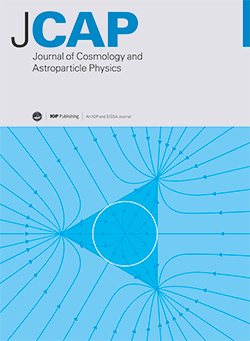Bayesian Deep-stacking for high-energy neutrino searches
IF 5.9
2区 物理与天体物理
Q1 ASTRONOMY & ASTROPHYSICS
Journal of Cosmology and Astroparticle Physics
Pub Date : 2025-06-26
DOI:10.1088/1475-7516/2025/06/064
引用次数: 0
Abstract
Following the discovery of the brightest high-energy neutrino sources in the sky, the further detection of fainter sources is more challenging. A natural solution is to combine fainter source candidates, and instead of individual detections, aim to identify and learn about the properties of a larger population. Due to the discreteness of high-energy neutrinos, they can be detected from distant very faint sources as well, making a statistical search benefit from the combination of a large number of distant sources, a called deep-stacking. Here we show that a Bayesian framework is well-suited to carry out such statistical probes, both in terms of detection and property reconstruction. After presenting an introductory explanation to the relevant Bayesian methodology, we demonstrate its utility in parameter reconstruction in a simplified case, and in delivering superior sensitivity compared to a maximum likelihood search in a realistic simulation.高能中微子搜索的贝叶斯深度叠加
在发现了天空中最亮的高能中微子源之后,进一步探测较暗的中微子源将更具挑战性。一种自然的解决方案是结合较弱的候选源,而不是单独的探测,旨在识别和了解更大群体的特性。由于高能中微子的离散性,它们也可以从遥远的非常微弱的源中被探测到,这使得统计搜索受益于大量遥远源的组合,即所谓的深度叠加。在这里,我们表明贝叶斯框架非常适合执行这种统计探测,无论是在检测和属性重建方面。在介绍了相关贝叶斯方法的介绍性解释之后,我们展示了它在简化情况下的参数重建中的效用,以及在现实模拟中与最大似然搜索相比提供优越的灵敏度。
本文章由计算机程序翻译,如有差异,请以英文原文为准。
求助全文
约1分钟内获得全文
求助全文
来源期刊

Journal of Cosmology and Astroparticle Physics
地学天文-天文与天体物理
CiteScore
10.20
自引率
23.40%
发文量
632
审稿时长
1 months
期刊介绍:
Journal of Cosmology and Astroparticle Physics (JCAP) encompasses theoretical, observational and experimental areas as well as computation and simulation. The journal covers the latest developments in the theory of all fundamental interactions and their cosmological implications (e.g. M-theory and cosmology, brane cosmology). JCAP''s coverage also includes topics such as formation, dynamics and clustering of galaxies, pre-galactic star formation, x-ray astronomy, radio astronomy, gravitational lensing, active galactic nuclei, intergalactic and interstellar matter.
 求助内容:
求助内容: 应助结果提醒方式:
应助结果提醒方式:


